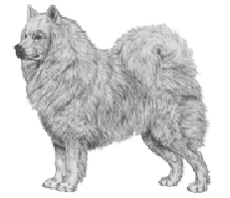Samoyed
General Information - Samoyed

Group:
Utility
Size:
large
Lifespan:
10-12 years
Exercise:
medium
Grooming:
medium
Trainability:
low
Watchdog ability:
very high
Protection ability:
very low
Area of Origin:
Russia (Siberia)
Date of Origin:
ancient times
Other Names:
Samoyedskaya
Original
Original Function:
Herding reindeer,
guardian, draft
History
The Samoyed comes from the northeastern regions of Siberia where a nomadic tribe called Samoyedes lived; hence, the breed's name. The dogs, descended from the Spitz family, were used to protect and drive the herds of reindeer from one place to another as the tribe travelled. They were also used as freight and pack dogs. It wasn't until the late 1800's that a fur-trader discovered the breed and brought some back to England in 1889. Development of the breed took place shortly thereafter, and the breed's popularity grew. Although the "Sammy" may be hard to housebreak at times, it makes an excellent family companion in the city or country, but thrives mostly outdoors.
Temperament
Known as the smiling dog, this breed is dependable and happy and loves nothing more than to play in the snow. This friendly and loyal dog loves the company of children. Samoyeds work best in teams and are much too friendly to be watchdogs, though they enjoy barking.
Upkeep
The Samoyed is active and needs a good workout every day, either in the form of a long walk or jog or a vigorous play session. It likes to pull and herd, and it loves cold weather. It can live outdoors in temperate to cold climates, but it much prefers to live indoors with its human family. Its thick coat needs brushing and combing two to three times a week, daily when shedding.
Samoyed
A breed standard is the guideline which describes the ideal characteristics, temperament, and appearance of a breed and ensures that the breed is fit for function with soundness essential. Breeders and judges should at all times be careful to avoid obvious conditions and exaggerations, as well as being mindful of features which could be detrimental in any way to the health, welfare or soundness of this breed.
Breed Standard - Samoyed
 Characteristics
Characteristics: The Samoyed is intelligent, alert, full of action but above all displaying affection towards all mankind.
General Appearance: The Samoyed being essentially a working dog, should be strong and active and graceful, and as his work lies in cold climates his coat should be heavy and weather-resisting. He should not be too long in back, as a weak back would make him practically useless for his legitimate work; but at the same time a cobby body, such as a Chow’s, would also place him at a great disadvantage as a draught dog. Breeders should aim for the happy medium, viz., a body not long, but muscular, allowing liberty, with a deep chest and well sprung ribs, strong neck proudly arched, straight front and exceptionally strong loins. Both dogs and bitches should give the appearance of being capable of great endurance but should be free from coarseness. A full grown dog should stand about 53.3 cm (21 in) at the shoulder. On account of the depth of chest required the legs should be moderately long, a very short-legged dog is to be deprecated. Hindquarters should be particularly well developed, stifles well angulated, and any suggestion of unsound stifles or cow hocks severely penalised.
Head and Skull: Head powerful and wedge-shaped with a broad, flat skull, muzzle of medium length, a tapering foreface not too sharply defined. Lips black. Hair short and smooth before the ears. Nose black for preference, but may be brown or flesh-coloured. Strong jaws.
Eyes: Almond shaped, medium to dark brown in colour, set well apart with alert and intelligent expression. Eyerims should be black and unbroken.
Ears: Thick, not too long and slightly rounded at the tips, set well apart and well covered inside with hair. The ears should be fully erect in the grown dog.
Mouth: Upper teeth should just overlap the underteeth in a scissor bite.
Neck: Proudly arched.
Forequarters: Legs straight and muscular with good bone.
Body: Back medium in length, broad and very muscular. Chest broad and deep, ribs well sprung, giving plenty of heart and lung room.
Hindquarters: Very muscular, stifles well angulated; cow hocks or straight stifles very objectionable.
Feet: Long, flattish and slightly spread out. Soles well cushioned with hair.
Gait: Should move freely with a strong agile drive showing power and elegance.
Tail: Long and profuse, carried over the back when alert; sometimes dropped when at rest.
Coat: The body should be well covered with a thick, close, soft and short undercoat, with harsh hair growing through it, forming the outer coat, which should stand straight away from the body and be free from curl.
Colour: Pure white; white and biscuit; cream.
Weight and Size: Dogs 50.8 to 55.8 cm (20 to 22 in) at the shoulder. Bitches 45.7 to 50.8 cm (18 to 20 in) at the shoulder. Weight in proportion to size.
Faults:
- Big ears with little feathering.
- Drop ears.
- Narrow width between ears.
- Long foreface.
- Blue or very light eyes.
- A bull neck.
- A long body.
- A soft coat; a wavy coat; absence of undercoat.
- Slack tail carriage; should be carried well over the back, though it may drop when the dog is at rest.
- Absence of feathering.
- Round, cat-like feet.
- Black or black spots.
- Severe unprovoked aggressiveness.
- Any sign of unsound movement.
Note: Male animals should have two apparently normal testicles fully descended into the scrotum.
DNZ No 680
Copyright Dogs New Zealand
01 Jan 2002
Any departure from the foregoing points should be considered a fault and the seriousness with which the fault should be regarded should be in exact proportion to its degree and its effect upon the health and welfare of the dog and on the dog’s ability to perform its traditional work.




